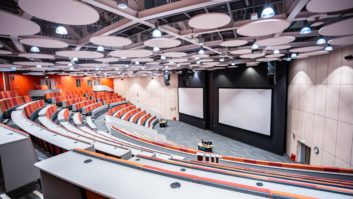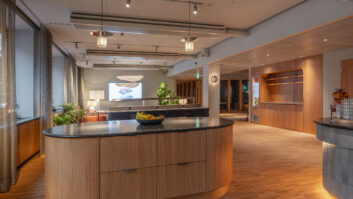Prysm has installed a 4.5m x 2.0m laser phosphor display (LPD) videowall in the newly opened Wallenberg Auditorium of the Royal Swedish Academy of Engineering Sciences (IVA). The academy is the world’s oldest academy of engineering sciences and its state-of-the-art auditorium has been totally refurbished and reopened with the primary objective of ensuring its status as the most cutting-edge auditorium in Scandinavia. The design and architecture of the auditorium, which is regarded as a national institution in Sweden, has been revitalised to showcase the very best of Scandinavian design today. Originally created in honour of industrialist Marcus Wallenberg Jr in 1983, his grandson Peter Wallenberg cut the ribbon to open the refreshed auditorium on Friday 22 February. Swedish materials have been used throughout, for example in the floor made from Borghamn limestone, walls covered with acoustic panels in laser-cut ash wood and chairs of ash veneer and leather. Prysm’s LPD display was selected as the visual solution for the auditorium by the integrator leading the project, Informationsteknik Stockholm.@page_break@When compared to competing technologies, such as LCD, LED and projection, Prysm’s LPD technology is said to be both more efficient and offering a unique combination of features and benefits. LPD technology lets designers and architects unleash their creativity with larger than lifesize displays of stunning clarity, brightness, and image quality. The tile-based architecture for the product allows designers to imagine formats in any size and any shape in nearly any environment. The image processor automatically scales video and images to the best possible resolution for a given display configuration. Through LPD’s surface immissive technology, displays are able to display crisp, clear images at viewing angles of up to 178˚. Long-lasting solutions also set LPD displays apart from competing technologies. With long lifespans and impressively low energy consumption, LPD displays are designed to reduce total cost of ownership. Prysm’s LPD technology consists of three main parts: the Laser Engine, the Laser Processor, and the Phosphor Panel. Built using solid-state laser diodes (like Blu-ray,) the laser engine generates modulated beams that energise the phosphor panel. To completely cover the display area, the beams are directed by mirrors. Combined with a fast refresh rate of 240 Hz, this results in flicker-free video with no motion blur.@page_break@The laser processor is the smart technology that manages the laser engine – turning it on and off, and varying its intensity. Along with the technology’s inherent low power consumption, this sophisticated approach to light management increases the display’s lifespan and lowers power consumption. The phosphor panel has a pattern of phosphors layered in a rigid glass or polymer structure. When excited by the laser engine, the panel emits red, green or blue light forming image pixels. Since the phosphor is printed extremely close to its surface, the display is able to achieve the highest possible viewing angle of any display technology on the market. Patrik Camp, Informationsteknik Stockholm’s managing director explained why Prysm was selected: “We were briefed by our client that all the AV also needed to be innovative in its field to fit with the ethos of the IVA and the superbly redesigned Wallenberg Auditorium. Prysm’s LPD videowall fits perfectly with its low power consumption, impressive uniformity and ultra-wide viewing angle, which was a key consideration for the 150-seat auditorium. “We are proud to be showcasing this technology in the Wallenberg Auditorium and have been very pleased with the support and engineering back up provided by Prysm.” www.prysm.com
Case study – Prysm selected for Stockholm’s prestigious Wallenberg Auditorium
Prysm has installed a 4.5 metre by 2.0 metre Laser Phosphor Display (LPD) videowall in the newly opened Wallenberg Auditorium of the Royal Swedish Academy of Engineering Sciences, IVA.







